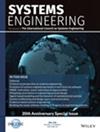Human factors hazard modeling in the systems modeling language
IF 1.6
3区 工程技术
Q4 ENGINEERING, INDUSTRIAL
引用次数: 0
Abstract
An ongoing challenge within the field of Systems Engineering is the application of a right‐scoped and consistent approach to modeling human functions and risks within a system lifecycle. Humans interacting with a system can be modeled along a continuum from passive agents with not well‐defined interfaces with the system operations, to essential personnel who are responsible for dynamic interactions that ensure the safety and correct function of the system. This paper seeks to contribute to the integration of a model of human function, response, and reliability into the systems engineering of a complicated system through translation of a Human Factors Hazard Model (HFHM) into the Systems Modeling Language (SysML). The HFHM is constructed as a sequential event tree model of human response to triggering events, where each event's likelihood of failure is modeled by a set of fault trees predicting human failure probabilistically using Human Error Probabilities (HEP). Implementation of this model in SysML is demonstrated through a set of stereotyped structural, behavioral, and parametric diagrams. Integration of the HFHM within SysML demonstrates the benefits of human factors modeling and integration into Model‐Based Systems Engineering (MBSE) processes illustrating executability, reusability, and traceability.系统建模语言中的人为因素危害建模
在系统工程领域中,一个持续的挑战是在系统生命周期中应用正确范围和一致的方法来建模人类功能和风险。与系统交互的人可以沿着一个连续体建模,从与系统操作没有良好定义接口的被动代理,到负责动态交互以确保系统安全和正确功能的基本人员。本文试图通过将人为因素危害模型(HFHM)翻译成系统建模语言(SysML),将人的功能、响应和可靠性模型集成到复杂系统的系统工程中。HFHM被构建为人类对触发事件响应的顺序事件树模型,其中每个事件的故障可能性由一组故障树建模,这些故障树使用人类错误概率(HEP)来预测人类故障的概率。该模型在SysML中的实现通过一组原型化的结构图、行为图和参数图来演示。HFHM在SysML中的集成展示了人为因素建模和集成到基于模型的系统工程(MBSE)过程中的好处,说明了可执行性、可重用性和可追溯性。
本文章由计算机程序翻译,如有差异,请以英文原文为准。
求助全文
约1分钟内获得全文
求助全文
来源期刊

Systems Engineering
工程技术-工程:工业
CiteScore
5.10
自引率
20.00%
发文量
0
审稿时长
6 months
期刊介绍:
Systems Engineering is a discipline whose responsibility it is to create and operate technologically enabled systems that satisfy stakeholder needs throughout their life cycle. Systems engineers reduce ambiguity by clearly defining stakeholder needs and customer requirements, they focus creativity by developing a system’s architecture and design and they manage the system’s complexity over time. Considerations taken into account by systems engineers include, among others, quality, cost and schedule, risk and opportunity under uncertainty, manufacturing and realization, performance and safety during operations, training and support, as well as disposal and recycling at the end of life. The journal welcomes original submissions in the field of Systems Engineering as defined above, but also encourages contributions that take an even broader perspective including the design and operation of systems-of-systems, the application of Systems Engineering to enterprises and complex socio-technical systems, the identification, selection and development of systems engineers as well as the evolution of systems and systems-of-systems over their entire lifecycle.
Systems Engineering integrates all the disciplines and specialty groups into a coordinated team effort forming a structured development process that proceeds from concept to realization to operation. Increasingly important topics in Systems Engineering include the role of executable languages and models of systems, the concurrent use of physical and virtual prototyping, as well as the deployment of agile processes. Systems Engineering considers both the business and the technical needs of all stakeholders with the goal of providing a quality product that meets the user needs. Systems Engineering may be applied not only to products and services in the private sector but also to public infrastructures and socio-technical systems whose precise boundaries are often challenging to define.
 求助内容:
求助内容: 应助结果提醒方式:
应助结果提醒方式:


